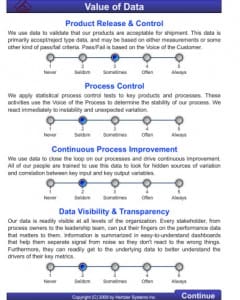In my last post I shared the Data Cost / Value Matrix and described companies that I’ve known that live in each of the four quadrants. While most people aspire to Quadrant A (Low Cost and High Value data), most don’t live there in reality. Many actually live in Quadrant D (High Cost and Low Value).
While these anecdotal descriptions of the four quadrants are useful, they don’t offer much guidance on what to do about your current reality.
For that reason, I developed a quick and dirty Gap Analysis that helps you quantify where you are today. Used properly, the Gap Analysis can point you to some actions that can help you become more data driven.
(I use the term Gap Analysis because it helps you evaluate the Gap in your current performance and your performance potential. Sometimes I like to say that your performance potential is how things would work if God ran the process.)
Anyhow –here is the interactive Gap Analysis Tool. (Note: you must have Adobe Flash Player installed to open this file.) Just answer the four questions as shown below, then click Continue to answer four more questions. Then click Results to see where you score.
Once you have your score, use the Back button to review your answers to each question and plot your strategy for improving your business.
Here are some questions that might help you develop a new strategy:
- Is your score better on the horizontal axis (Data Cost) or on the vertical axis (Data Value)? If you’re firmly in Quadrant C (Low Cost and Low Value) it is obvious that you need to work on increasing the value of your data. If both scores are low, look for the low hanging fruit. Often this is found in data completeness and automation. Automation will free up time from the data shuffle so that you can work at making better use of the data that you’re collecting.
- Where are your lowest scores? Often bringing one score up from Never to Seldom or Seldom to Sometimes will do a lot to improve your performance.
- Are your scores balanced across all eight categories, or are some significantly better than others? As a rule, I’d encourage you to seek a balance across all aspects, rather than strive for excellence in one aspect at the expense of the others.
These are just some of the ways you can use this data to become more data driven. Here is some information about a more complete Gap Analysis that we can help you with too.
In the meantime, does your score on this Gap Analysis reflect the reality of your business? Tell me what you think. Use the ShareThis button below to mark this page, leave a comment, tweet me, schedule a conversation, or call 800-958-2709.
One Comment
Comments are closed.




[…] written a lot about the value and cost of data. You can take a short, eight-question evaluation of how well your organization uses data. You can find lots of case studies of how people use data to make better business decisions and […]